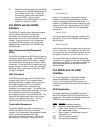
26
6) Answers are coming back from the SR530
too slowly due to the W6 default setting for
the character interval time. Use the W
command to speed up the transmission
from the SR530. This can cause
problems for the GPIB interface if the echo
mode is on (switch 6 of SW1).
The SR530 with the RS232
Interface
The RS232 is a popular serial interface standard
for bit serial communication. Despite the
existence of the standard there are many
permutations of control lines, baud rates, and data
formats. If you do not have a lot of experience
interfacing RS232 equipment you should read
Appendix B for a description of the RS232 and
interfacing tips.
Data Communications Equipment
(DCE)
The SR530 is configured as DCE so that it may be
connected directly to a terminal. If the SR530 is to
be interfaced with another DCE device, a special
cable (sometimes referred to as a 'modem' cable)
is required. To use the RS232 interface you must
set the switches in SW2 to match your computer's
baud rate, parity, and number of stop bits. Refer
to Page 7 for details.
Wait Command
The SR530 normally waits until the RS232 'Clear
to Send' control line (CTS) is asserted before
sending characters. However, some computers
do not set and reset the CTS line, possibly
causing the SR530 to send data when the
computer is not ready to read it. The SR530 may
be 'slowed down' using the W command. Sending
'Wn' causes the unit to wait nx4 mS before
sending each character over the RS232 bus. The
command W0 sets the wait interval to zero and
results in the fastest transmission. The wait
interval is set to 6 (24 mS)on power-up.
Termination Sequences
The default RS232 termination characters are
sufficient to interface with most computers,
however, it will occasionally be necessary to send
special terminating sequences to fit the
requirements of some computers. This can be
done with the J command. The format for the
command is:
J {n1,n2,n3,n4}
where n1, n2, n3, and n4 are decimal values
between 0 and 255 corresponding to the ASCII
codes of the desired termination characters. For
instance, if the desired termination sequence is an
asterisk, (ASCII 42), two carriage returns, (ASCII
13), and a line-feed, (ASCII 10), the appropriate
command is:
J 42,13,13,10
If a G command is sent requiring an answer of 24
(sensitivity = 500 mV), the SR530 would respond
with the string
24*<cr><cr><lf>
Up to four terminating characters may be specified
by the J command. If no arguments are sent with
the J command, the terminating sequence returns
to the default (echo on: <cr><lf>; echo off: <cr>).
The J command does not affect the terminating
character (<cr>) required at the end of commands
received by the SR530. It also does not affect the
terminating sequence sent with data over the
GPIB interface.
The SR530 with the GPIB
Interface
For a brief introduction to the GPIB standard,
please read Appendix C at the back of this
manual. Before using the GPIB interface you
must set the switches in SW1 per the instructions
on page 7.
GPIB Capabilities
The GPIB capabilities of the SR530 consistent
with IEEE standard 488 (1978) are shown in the
table below. Also shown are the responses of the
SR530 to some standard commands.
Code Function
SH1 Source handshake capability
AH1 Acceptor handshake capability
T5 Basic Talker, Serial Poll, Unaddressed to
talk if addressed to listen
L4 Basic Listener, Unaddressed to listen if
addressed to talk
SR1 Service request capability
PP0 No parallel poll capability


















